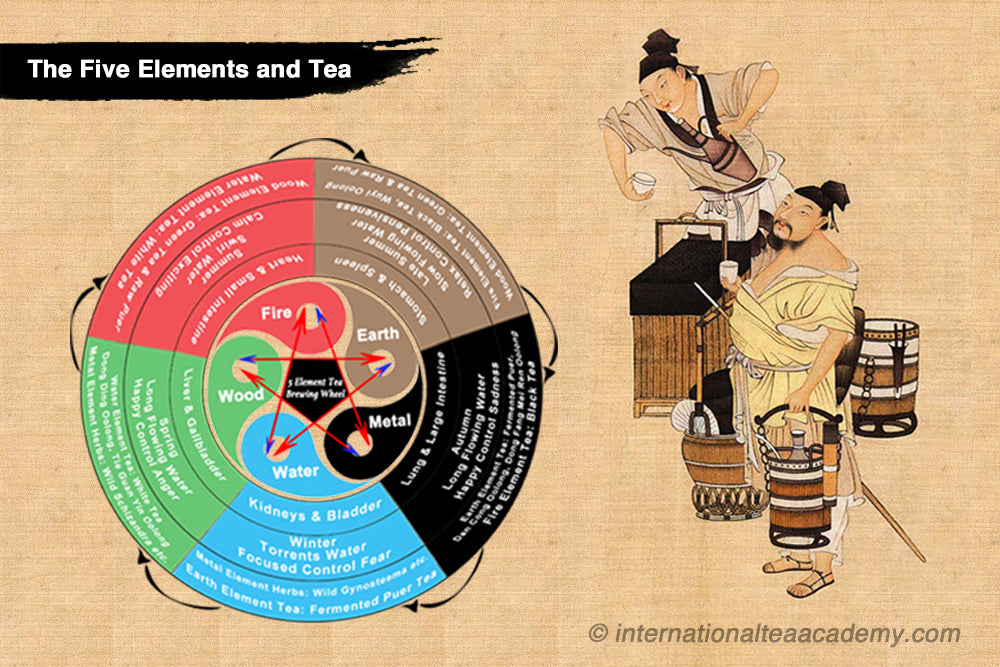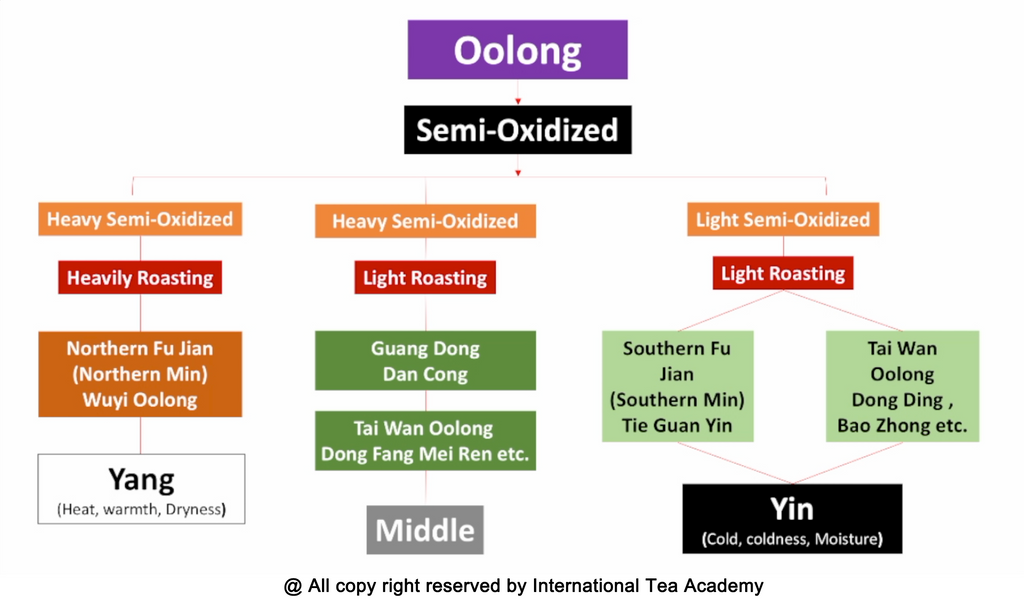
Having clarified which organs need which elements of teas or herbs and which brewing methods according to the Five Elements system, I think we can get the perfect cup of healthy teas for different people by following these basic rules.
Now, I would like to go deeper into certain questions so you can understand the theory more thoroughly.
Q1- Based on what theory do we know which teas relate to which of the Five Elements?
In the ancient book on traditional Chinese medicine, The Yellow Emperor's Classic of Medicine, it was recorded that:
Green belongs to Wood
Red belongs to Fire
Yellow belongs to Earth
White belongs to Metal
Black belongs to Water
So we can simply match the five different colors of tea with the five different elements based on this prescription. But rather than blindly follow this ancient dictum, it’s important to understand the theoretical basis behind these pairings. People have forgotten one important thing: how these five different colors of teas have been processed:
Green tea has an important step in processing called “killing the green.” Killing the green is also referred to as “de-enzyming” or “fixing,” and is a process of green tea manufacture used to halt the oxidative browning of tea leaves by denaturing the enzymes responsible for oxidation – polyphenol oxidase and peroxidase. This important step in the processing of green tea does more than give green tea its characteristic color. Many of the bioactive compounds in the tea leaves make it into the final drink, which contains large amounts of important nutrients. It is loaded with polyphenols like flavonoids and catechins, which function as powerful antioxidants. This processing retains most of the original “tea wood” characteristics. So, without doubt, green tea belongs to the Wood element.
To produce Black Tea, the most important step is oxidizing. The tea leaves are exposed to oxygen for several hours, which causes chemical changes in the leaves and turns them from green to coppery red, until the leaves are completely oxidized, then fired (or dried) to stop oxidation. Unlike green tea, black tea, once processed, is cleared of all antioxidants that it once contained. The oxidizing step of processing perfectly matches the Fire element. Fire is the rapid oxidation of a material in the exothermic chemical process of combustion, releasing heat, light, and various reaction products.
Black tea is known for protecting the stomach and intestines, as the enzymatic oxidization that happens during fermentation reduces the amount of polyphenols in black tea. Thus, black tea becomes gentler, and will have red liquid and red leaves. Furthermore, as polyphenols may stimulate the stomach, and acts stronger on an empty stomach, black tea with a lower amount of polyphenols can help protect your stomach. Black tea can be mixed with sugar and milk. Regular drinking of it can diminish inflammation in your stomach, protect stomach lining, and even help cure gastric ulcers.
Yellow tea is similar to green tea in many ways. In fact, the initial production process of both teas is the same. However, the production of yellow tea requires additional steps.
This use of steam in killing the green tea leaf enzymes is an important step in processing tea, with the leaves then quickly cooled down before undergoing further processing. The less tightly controlled methods of killing the green in past times resulted in the creation of "yellow tea" when the tea leaves were over-steamed or were not quickly spread out, doused with water, and cooled. This step gives yellow tea its yellow color, and is also the step that provides half the oxidation for the leaves. It also removes the grassy flavor that is characteristic of green tea.
Fermented Puer Tea is also known as ripe puer tea. The key to creating fermented puer is fermenting. The process used to convert mao cha (raw puer tea) into ripened puer is a recent invention that manipulates conditions to approximate the result of the aging process by prolonged bacterial and fungal fermentation in a warm humid environment under controlled conditions, a technique called wodui (渥堆, "wet piling" in English). This involves piling, dampening, and turning the tea leaves in a manner much akin to composting.
Both yellow tea and fermented puer tea (ripe puer tea) are affected by changes in the environment. Whether it’s bacterial, fungal fermentation, or yellow tea’s special oxidation, everything is related to the influence of the environment. In the flavors of some fermented puer teas, we can even detect an earthy flavor, so they both belongs to the Earth Element.
Now, let’s Jump to the Water element.
Based on color alone, white tea should belong to Metal. But if we look deeper, we discover new dimensions to this theory.
The taste of white tea is very smooth and well known as being rich in antioxidants. In traditional Chinese medicine, white tea is well known for its benefit of smoothing out the functioning of the liver.
White tea is not fermented and the process is very simple. Right after plucking the leaves, they’re put in the shade or in a dark room with fresh air to dry and cool naturally. This kind of processing is perfectly matched with Water’s nature, as that is the same way water dries.
Next, let’s take a look at the Metal element. The reason we didn’t categorize tea as being part of the Metal element is that in the Five Elements system, Metal is the element that can clean and naturally remove impurities from the soil. In traditional Chinese medicine, Metal foods can encourage energy to expand and move outward, and this type of energy normally relates to food with a pungent taste (no kind of tea – “tea” referring to Camellia sinensis, specifically – will have pungent taste). To keep our body in true Yin Yang balance, we need other herbs with Metal energy to move forward.

Q2 - Based on what theory do we know which teas relate to which organs?
We’ve talked about how most of the major types of tea belong to the different elements. We haven’t yet mentioned how one other important type of tea relates to the Five Elements, and that’s oolong tea. I didn’t forget it – I just wanted to mention this tea separately for you now.
Oolong teas mostly originate in four major areas of China: Northern Fujian Province, Southern Fujian Province, Guangdong, and Taiwan.
Min is the nickname of Fujian Province. Fujian Province also has a river called the Min River, which is a geographical boundary dividing Fujian Province into east, west, north and south. We call oolong tea from north of the Min River “Northern Min Oolong”; the oolong from south of the Min River, we call “Southern Min Oolong.”
The most famous and typical Northern Min Oolong is Wuyi Oolong from Wuyi Mountain.
The most famous and typical Southern Min Oolong is Tie Guanyin from Anxi County. In Guangdong province, the most famous Oolong is Fenghuang Dancong, translated into English as “single bush” or “single trunk”, and it comes from Phoenix mountain.
Taiwan is famous for its production of oolong tea. 90% of tea produced there is oolong.
The reason oolong requires separate treatment is that it doesn’t have the same processing method as other teas, and it uses different varieties of tea leaves. On top of that, oolong tea is processed differently in different locations. The production process is what merits classifying oolong differently than other teas.
Oolong tea has to go through the very important step of semi-oxidation. This means that during production, oxidation is initiated, controlled, and halted at some point before the leaves are considered fully oxidized. Controlling and halting the oxidation decides the final type and flavor of the oolong.
The last step of processing oolong is roasting. Different methods of roasting, different temperatures, and different timings will decide the final aromas and flavors of oolong, too.
Also, these two major steps decide which element any particular oolong belongs to.
Basically, based the different locations, oolong can generally be separated into 3 different styles of oxidization and roasting.
One is heavy semi-oxidization with heavy roasting, which means that the duration and temperature for semi-oxidation and roasting are the longest and highest.
Northern Fujian Province produces the most famous oolong, called Wuyi Oolong, which uses this type of processing.
Another type is heavy semi-oxidation with light roasting. In Guangdong province, the most famous oolongs are Dancong and Taiwan’s Dongfang Meiren 东方美人 (In English: Oriental Beauty), which both use this type of processing.
The third one is light semi-oxidation with light roasting. Southern Fujian Province’s Tie Guanyin and Taiwan’s Dongding and Baozhong Oolong use this type of processing.
In the previous section, we already mentioned that only when Yin Yang is in balance can we live long and in good health. The ancient book on traditional Chinese medicine, The Yellow Emperor's Classic of Medicine, says, “Yin and Yang serve as the Tao (law) of the heavens and the earth, the fundamental principle of all things, the parents of change, the beginning of birth and death and the storehouse of Life. The treatment of disease must follow this law.
" Yin is that which maintains and endures, it is nourishing and supports growth and development as well as being something contracting and moving inward. It also includes the following: Cold, coldness, Moisture. Yang is that which is creative and generating, it develops and expands; it is dynamic and full of movement. It also includes the following: Heat, warmth and Dryness.”
So based on the theory of Yin and Yang, combined with our understanding of the processing methods of different types of oolong teas, we can clearly see that:
Northern Fujian (Northern Min) Wuyi Oolong is Yang;
Southern Fujian (Southern Min) Tie Guanyin and Taiwanese Dongding Oolong and Baozhong Oolong are Yin;
And Guangdong Dancong Oolong and Taiwanese Dongfang Meiren (Oriental Beauty Oolong) lay somewhere between Yin and Yang.

As previously mentioned, we have to follow the rules of the Five Elements, using different brewing methods in different seasons, to keep our bodies in healthy balance.
And now, we’ve described each type of teas’ processing in relationship to each of the Five Elements.
So I made a table summarizing which of the Five Elements belong to Yin, and which belong to Yang. You can use this form to help you find the right tea in the right season for keeping each organ in healthy balance using the various tea brewing methods.

You can also download our Five Elements Tea Brewing wheel from our online tea course - Ancient Chinese Science & Art of Brewing Tea. This wheel will help you choose the right tea in the right season, using the appropriate tea brewing method, to treat the different organs and emotions.
For more informations, please check
• ITA Certified Online Course - Ancient Chinese Science & Art of Brewing Tea
• Tea book 5 Element Tea
• More you can learn from our Online Tea Courses
@ All copy right reserved by Wild Tea Qi & International Tea Academy
Comments will be approved before showing up.